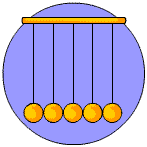Newton's Laws of Motion
Created | Updated Dec 24, 2012

As well as being the foundation of physics, these laws are very useful when playing snooker.
Sir Isaac Newton formulated the following laws in his book Philosophiae Naturalis Principia Mathematica (The Mathematical Principles of Natural Philosophy). They might not seem like much, but they helped to define the concepts that led to Newton's discovery of the mathematical laws governing gravity, and that's no mean achievement.
First Law
Any object in a state of rest or of uniform linear motion will remain in such a state unless acted upon by an unbalanced external force. Basically this means that the velocity (speed and direction) of the object will remain unchanged if no such force acts on it. (If an object has zero velocity it is at rest.)
Second Law
An unbalanced force acting on a object produces an acceleration in the direction of the force, directly proportional to the force, and inversely proportional to the mass of the object. In other words, if the force is vector F, the mass is scalar m, and the acceleration is the vector a, then F = ma.
Third Law
For every action (or force) there is a reaction (or opposing force) of equal strength but opposite direction.
The last law is sometimes said to be a mathematical version of Murphy's Law. And sometimes it isn't.

